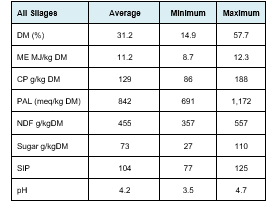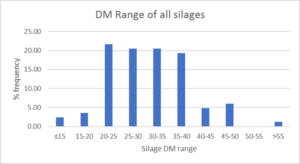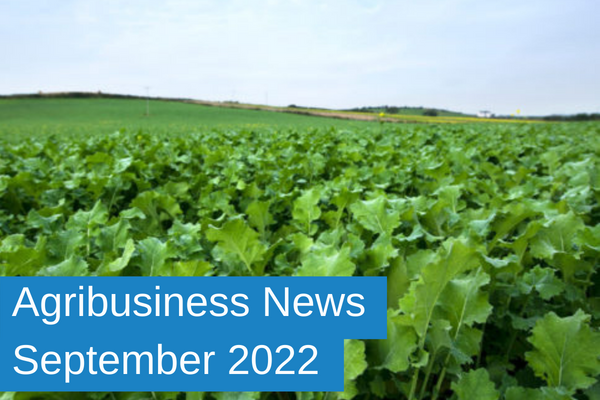Agribusiness News September 2022 – Inputs: Feed & Forage
1 September 2022As winter approaches, it is vital to have forage analysed to accurately measure the nutritional value and use this information to make the most from forage and plan a feed budget. The nutritional value of silage is determined by several factors such as grass variety, cutting date, weather, wilting period etc. With high purchased feed costs, knowing the nutritional content of the silage allows for targeted feeding and supplementation where appropriate with concentrates.
The table below highlights the significant range in the 2022 silages analysed by the SAC lab. The silages analysed so far include 1st cut dairy silages(pit) and beef and sheep 1st cut silages (pit and bale).
2022 SAC Silage Analysis Results
While the average figures are overall quite good for, energy (ME) and protein (CP), at the lower end significant supplementation will be required if productivity is to be maintained.
The average dry matter of these mainly first cuts silages is perhaps not as high as expected with an average of 31.2%. Looking further into the data the chart below shows the overall distribution of silages received, with around 1/3 of silages analysing at less than 25% DM. Catchy weather around cutting time could explain their relatively low dry matter.
It is predicted that this DM average will increase as subsequent cuts are sent in for analysis, however, this shows the importance of having different cuts/stacks of bales analysed as year on year DM is always the biggest variable e.g. If for example you have 50 bales weighing 600kg at 35% DM, this is the equivalent of 525kg of DM, enough to feed 53 dry suckler cows. However, if they analysis is only 25% DM, equivalent of 375kg of DM, this is only enough to feed 38 dry suckler cows – 71% of the herd. Highlighting the importance of knowing the DM both for rationing and for feed budgeting.
In terms of feed costs, prices should be treated as a guide only as they are currently changing often weekly and, in some cases, daily. Delivered costs are based on 27-tonne load, therefore load size and location will alter prices. At the time of writing (end of August) quotes for Hi-Pro Soya delivered are around £495-520/t, rapeseed meal is reasonable value at around £333/t. More people are turning to protected rapeseed meal alternatives as a replacement to soya as they provide a good source of bypass protein.
Other good protein sources subject to availability are distillers grains at ~ £350/t ex distillery (prices depend on location), Maize gluten(20% protein) ~£330-348/t, and pot ale syrup quoted to be a round £100-109/t delivered. Little to no draff available, therefore no prices available.
Feed barley delivered is priced at £225-230/t and feed wheat £251/t, nutritionally feed wheat is worth around £20/t more than barley. Price of bruising is around £15/t and those that have or are considering alkali treating their grain this year to boost protein value are quoting around £35/t for treatment cost. Due to volatility of urea prices however this is likely to fluctuate.
While the guide price for sugar beet pulp is ~ £400/t but supply is very tight. Soya hulls are likely to be the best value fibre source replacement and has good availability with quotes sitting around £318/t for full loads delivered.
The importance of planning ahead
Don’t be caught out this winter – forward plan your feed budget, contact your suppliers and sit down with your feed adviser sooner rather than later. The farm advisory service has some excellent resources on how to create a feed budget available https://www.fas.scot/downloads/a-guide-to-feed-budgeting/ and a forage budgeting app available to download at https://www.fas.scot/app/.
Mary.young@sac.co.uk
Sign up to the FAS newsletter
Receive updates on news, events and publications from Scotland’s Farm Advisory Service



